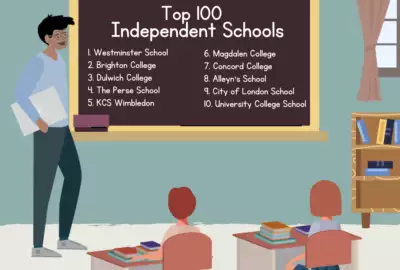Expert Insights
How To Check School Waiting Lists
Published 15th November 2024 by Rosamond Bowman

Waiting Lists Explained: How To Check School Waiting Lists
In the admissions process, independent schools carefully consider applicants at various age levels, including 7+, 8+, and 11+. One outcome parents may encounter is their child being placed on a waiting list.
To provide helpful advice on this matter, we consulted with Rosamond Bowman, an expert school consultant and former head teacher with over forty years of experience. She shared insights on how parents can approach this situation thoughtfully.
Join our community for free and stay updated on academic topics that matter to you and your family.
A school waiting list is a system used to track children who were not initially offered a place at their preferred school but whose parents have requested that they still be considered if a spot becomes available. These lists are typically maintained for schools that are oversubscribed, meaning they have more applicants than available spaces.
Placement on a waiting list is often determined by the same criteria used for admissions, such as proximity to the school, sibling attendance, or special circumstances. While being on the waiting list does not guarantee admission, it keeps the possibility open if another child withdraws or declines their offer.
Each school manages its waiting list independently, following the policies set by the relevant education authority or governing body. Parents are usually informed of their child’s position on the list, though this position can change as other children are added or removed based on the same admission criteria.
For many families, the waiting list provides a second chance at securing a spot in their desired school, particularly when no other options are as convenient or appealing. It is important for parents to stay in regular contact with the school and keep their information up to date, as this ensures they remain eligible for consideration should a vacancy arise.
National Offer Day is the day when local authorities in the UK notify parents of the primary school place allocated to their child for the upcoming academic year. This typically occurs on or around 16th April each year for reception class places and on 1st March for secondary school places.
Parents receive notification either by email or post, and they can also log in to an online portal to view the offer. National Offer Day is an important milestone in the school admissions process, especially for parents who have applied for places at oversubscribed schools or schools outside their local catchment area.
School places are typically allocated based on a set of criteria established by the local education authority or the school itself, depending on the type of school. The process starts with parents submitting applications, listing their preferred schools in order of priority.
Schools then review applications based on their admissions policies, which often include factors such as proximity to the school, whether the child has siblings already attending, and specific needs such as special educational requirements.
Once all applications are reviewed, offers are made to families, usually for the highest-ranked school on their list that has available spaces. If a school is oversubscribed, meaning it has more applicants than places, children who do not meet the criteria or rank lower are not offered a place.
These children may be placed on a waiting list or allocated a place at an alternative school with available capacity. Appeals can be made if parents feel the allocation process was unfair or did not follow proper procedures.
School waiting lists operate based on the admission criteria set by each school, rather than on a first-come, first-served basis. A child’s position on the list depends on how well they meet the school’s admission priorities, such as living close to the school, having a sibling enrolled, or other specific factors.
The waiting list number assigned to your child reflects how many other children are ahead of them, meaning the number of students who would need to leave the year group for your child to be offered a place.
If a spot becomes available, it is automatically offered to the child who holds the top position on the waiting list at that time. This position can change as new applicants are added or removed, or if other children’s circumstances, such as proximity or sibling status, are reassessed.
To stay eligible, parents should regularly check the school’s admission criteria and ensure their application details remain up to date.

Ultimately, being placed on a waiting list means your child probably fell just short of the competition during assessment, either in exams or at interview.
Applying for entrance at 7+, 8+ or 11+ is an incredibly competitive and intense process, so first of all you need to make sure your child doesn’t take this seeming rejection too badly: it has been a tough process for them up to this point.
Now it is out of their hands there is no point in making it tougher. The important thing is making a decision, so they know what happens next.
One important initial consideration is how long the waiting list is, and how far down it your child is. The former will vary from school to school. Schools will try and pre-empt how many of their offers will be accepted and plan accordingly. The size of the school (and the number of places it offers), where the school is located, the presence of any siblings at the school, and their communications with other schools will all influence not only their final offers, but also the size of the waiting list.
Supporting your child emotionally while they are on a waiting list for a school place can be challenging, but there are several strategies you can use to help them through this uncertain time:
Open communication: Encourage your child to talk about their feelings and concerns regarding the waiting list. Listen attentively and validate their emotions, letting them know that it's okay to feel anxious or disappointed.
Maintain routine: Keep your child's daily routine as normal as possible to provide stability and a sense of normalcy during this uncertain period.
Stay positive: Maintain a positive attitude and reassure your child that everything will work out. Focus on the exciting possibilities that lie ahead, regardless of the outcome of the waiting list.
Encourage distractions: Engage your child in activities they enjoy to help distract them from worrying about the waiting list. This could include hobbies, sports, or spending time with friends and family.
Set realistic expectations: Help your child understand that being on a waiting list does not guarantee a place and that it's okay to have a backup plan in case they are not offered a spot.
Stay informed: Keep in touch with the school for updates on the waiting list status and any changes that may affect your child's chances of being offered a place.
Seek support: If your child is struggling with anxiety or stress, consider seeking support from a therapist who can help them cope with their emotions during this challenging time.
By providing your child with love, support, and understanding, you can help them navigate the emotional challenges of being on a waiting list and prepare them for whatever the future holds.

Again, this will vary from school to school. You will need to bear in mind some of the considerations discussed above. For example, with more prestigious schools, the chances of offers being declined are correspondingly less and so it’s unlikely they’ll get very far into the waiting list. For larger schools, with more offers going out, there might be greater use of the waiting list (but that list itself might also be longer).
From both of these examples it is clear that an important point will be exactly how far down the waiting list your child is. Most schools will rank the waiting list in priority order based on the result of assessments. Accordingly, a good first step is to try and find this out from the school. Give their office a call and ask them directly. Not all schools will give you this information, but if they do then it will give you an important bit of information to factor into your decision.
Communicating effectively with a school while your child is on a waiting list can help you stay informed and demonstrate your continued interest. Here are some tips:
1. Be polite and respectful: Maintain a positive and respectful tone in all communications with the school, even if you're feeling frustrated or anxious.
2. Follow the school's communication guidelines: Some schools may prefer email, while others may prefer phone calls. Follow the school's preferred method of communication to ensure your messages are received promptly.
3. Ask for updates: Politely inquire about your child's position on the waiting list and whether there have been any changes. This shows your continued interest and keeps you informed.
4. Provide relevant information: If there have been any changes in your circumstances or your child's achievements since you submitted your application, inform the school. This information may be relevant to their decision-making process.
5. Express your interest: Reiterate your interest in the school and your desire for a place if one becomes available. This can help keep your child's application fresh in the school's mind.
6. Respect their decision: If the school informs you that they are unable to offer your child a place, thank them for considering your application and ask if there is anything you can do to improve your child's chances in the future.
7. Stay informed: Keep yourself informed about the school's admissions process and any deadlines or requirements they may have. This shows your commitment and preparedness.
By communicating effectively with the school, you can stay informed about your child's position on the waiting list and demonstrate your continued interest in the school.

If your child was not offered a place at your preferred school and you are unhappy with the decision, you can appeal through the formal appeals process. The steps for appealing typically include the following:
Appealing is a formal process, but being prepared and presenting a strong, evidence-backed case can improve your chances of success.
The most important consideration should always be the welfare and happiness of your child. Remember that this has been a gruelling, stressful process for them. At this stage it might give them greater contentment and security to take a firm offer at a school they are happy with than hold out for something else.
Think about what is best for them. Whilst it might be that they eventually do get an offer from a waiting list, do you want them to be going somewhere where they were at the bottom of the pile? Arriving at this school, your child could struggle with self-confidence after the initial rejection and might then have to deal with other students outpacing them.
In the end, they could be less happy, having waited, than if they’d gone for the firm offers, they’d initially received. Although these are tough realisations and tough decisions, if they result in your child being happy then they are worth it.
There is also a more practical consideration to do with timing. Whilst actual offers typically have pretty firm deadlines by which to respond, waiting lists will drag and drag depending on the responses of other parents and their changes of plan. This time limit makes it even more of a gamble to hold out for a place via a waiting list.
Therefore, if you have firm offers on the table there is a strong argument in favour of accepting the one your child most wants to attend.
Many families these days, bearing in mind the above factors, try to hedge their bets by both accepting firm offers and keeping their child on school waiting lists. Then they can turn down the initial firm offer if a waiting list place comes through.
There are a number of reasons why this might not be as clever as it sounds. The first factor is financial - most schools require you to put down a deposit when accepting a place, which you forfeit if you then go back on it. More seriously, schools don’t like to be messed around and will communicate with each other.
If your child has any siblings, they are very unlikely to ever be given a place at the snubbed school. Finally, it leaves your child with more uncertainty and potentially more worry.
Ultimately, plan around making it easier for your child and go from there. If that means taking a firm offer, even if it wasn’t your first choice, then that’s the way to go. If it means going on a waiting list, then it’s a gamble, but one where you know the risks and are still happy to take them on.
Waiting lists for school places typically end when the school year begins and all available places have been filled. However, the exact timing can vary depending on the school and the circumstances. In some cases, schools may continue to admit students from the waiting list even after the school year has started if places become available due to other students leaving.
Hopefully this has helped you make sense of school waiting lists. If you are still unsure, or faced with a tricky decision, don’t hesitate to contact Ivy Education and speak with one of our expert consultants!
Before removing your child from a school waiting list, it’s important to consider the potential risks and rewards. Once removed, your child may lose their original position, and rejoining the list later might not be possible. If you’re uncertain, ask the school for updates on your child’s position or clarification on policies to make a more informed decision about whether to stay on the list.
If you decide to proceed, you can remove your child by contacting the school or local education authority in writing. This ensures their name is officially taken off the list, freeing the spot for another family. Families often choose this option after accepting a firm offer elsewhere or to avoid prolonged uncertainty for their child.
An independent school waiting list is a list of students who have not been offered a place at a school but may be offered one if a place becomes available. Students are placed on the waiting list based on their performance in entrance exams or interviews.
Your child may be placed on a waiting list if they were not initially offered a place due to high competition for limited spots. This could be because other students performed better in entrance exams or interviews.
The length of waiting lists varies depending on the school and the number of students who decline offers. Some schools may have shorter lists if they anticipate fewer declines, while others may have longer lists.
The chances of getting an offer from a waiting list vary depending on factors such as the school's popularity, the number of offers declined, and your child's position on the list. It's advisable to inquire with the school about your child's position for a better understanding.
It's a personal decision, but accepting offers from other schools can provide your child with a guaranteed place. However, if you are confident in your preference for a particular school and are willing to wait, you may choose to decline other offers and remain on the waiting list.
Most schools have appeal procedures in place. If you believe there has been an error in the assessment process or have significant new information to provide, you can usually submit an appeal. However, success is not guaranteed.
You can demonstrate continued interest in the school by attending open days or events, keeping in touch with admissions staff, and providing any relevant updates on your child's achievements or activities. However, there are no guarantees.
When deciding whether to remain on a waiting list, consider your child's happiness and well-being, the practicalities of timing and deadlines, and the likelihood of receiving an offer based on your child's position and the school's historical data.


















